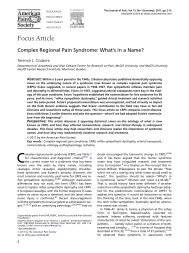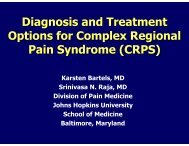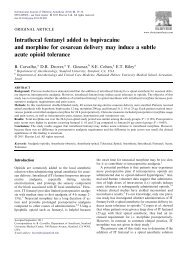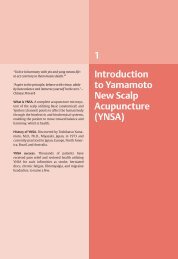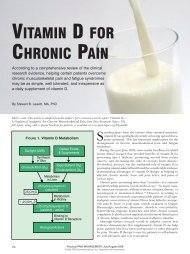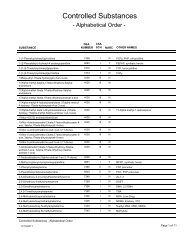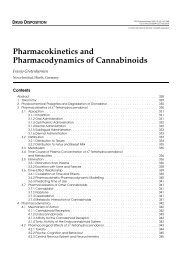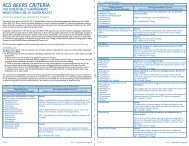REVIEWSused in humans to treat autoimmune diseases, includingrheumatoid arthritis 105 .Its mechanism of actioninvolves elevating the concentration of extracellularadenosine, a potent endogenous anti-inflammatory 106,107 .Low-dose methotrexate also decreases production ofpro-inflammatory cytokines 95,108,109 ,hydrogen peroxide 110and prostaglandin E 2(REF. 110).In addition, methotrexatecan increase IL-10 production 111 .Furthermore, methotrexatehas been proposed to be a competitive inhibitorof IL-1 binding to its receptor 112 , as methotrexate disruptsIL-1-induced effects 113,114 .This profile indicatesthat systemic methotrexate would be able to suppressallodynia and hyperalgesia resulting from spinal cordglial activation. As noted previously, methotrexate bothprevented and reversed established enhanced nociceptiveresponses in rats and reduced some anatomicalindices of spinal cord glial activation 55 .However,thereare concerns about the use of this drug as an inhibitorof spinal cord glial activation. For example, the dosageneeds to be carefully considered. Methotrexate canactivate astrocytes (as reflected by GFAP expression),induce astrocyte proliferation, as well as cause degenerativechanges in these cells 103,104 .Indeed, astrocytesare the primary targets for methotrexate neurotoxicity103,115 .So dosage would need to be adjusted toavoid potential glia-activating and glia-toxic effectswhile maintaining beneficial suppression of glial proinflammatorycytokines.Although glia-toxic side effects are a concern formethotrexate, no such concerns arise for inhibitors ofp38 MAP kinase. This group of compounds are beingdeveloped for clinical targets including Crohn’s disease,pancreatitis and rheumatoid arthritis 116 .These compoundsvary in their bioavailability, with some beingorally active (for example, SCIO-469 and SCIO-323;Scios) and others requiring injections (for example,CNI-1493; Cytokine Pharmasciences). Some, suchas CNI-1493 and NPC037282 (Scios) are active inspinal cord after systemic administration 51,52 .Theyvary in their cross-reactivity with other intracellularsignalling cascades 116,117 .Highly selective p38 MAPkinase inhibitors are in development 49 .This group of drugs is intriguing with respect totheir potential for controlling glially driven exaggeratedpain, for a number of reasons: pro-inflammatorycytokines activate (that is, phosphorylate) p38 MAPkinase 118 ; p38 MAP kinase activation is one of themajor intracellular signalling cascades leading to denovo production of pro-inflammatory cytokines 47,119 ;and (as noted above), at least some of these compoundscross the blood–brain barrier, making systemic administrationof the drugs plausible 51,52 .In rat spinal cord,microglial p38 MAP kinase activation has beendetected immunohistochemically in response to nociception-enhancingperipheral inflammation, peripheralnerve injury, spinal nerve ligation and peri-spinal substanceP 48,49,120,121 . p38 MAP kinase inhibitors do notaffect basal nociception. Rather, they block exaggeratednociception induced by tissue inflammation 17,48 ,peripheral nerve inflammation 19 , spinal nerve ligation50,120 , spinal cord inflammation 18 ,and peri-spinalNMDA and substance P 48,49 .Although CNI-1493reverses established allodynia induced by sciatic nerveinflammation 19 , SB203580 (Calbiochem) and SD-282(Scios) failed to reverse established spinal sensitizationinduced by spinal nerve ligation 50 or peripheralinflammation 48 .Whether these different outcomesreflect different nociceptive potencies of the models,different durations of phospho-p38 MAP kinaseinvolvement in pain maintenance across differentmodels, the inhibition of Jun N-terminal kinase aswell as p38 MAP kinase by CNI-1493 (REFS 116,117) orother factors is not yet clear.One potential issue for this class of drugs is thatp38 MAP kinase is expressed by neurons as well as byglia. Peripheral inflammation, chronic constrictioninjury and spinal nerve ligation increase activated p38MAP kinase in small-diameter neurons in the dorsalroot ganglia, as well as activating p38 MAP kinase indorsal horn microglia 50,120,121 .Activation of p38 MAPkinase in dorsal horn neurons, as well as in microglia,occurs in response to topical capsaicin and peri-spinalNMDA 49,51 .It will be important to identify the downstreameffects of p38 MAP kinase activation in neurons,so as to understand the impact of inhibitors onthe pain pathway.The last compound to be discussed is the antiinflammatorycytokine IL-10. The use of IL-10 is anintriguing approach to glially driven allodynia andhyperalgesia, as IL-10 can suppress the productionand activity of TNF, IL-1 and IL-6. IL-10 can exert thiseffect by inhibiting: p38 MAP kinase 47,60 ;NF-κB activation,translocation and DNA binding 60 ;pro-inflammatorycytokine messenger RNA transcription, stabilityand translation 47,122–124 ; and pro-inflammatorycytokine release 61 .In addition, IL-10 stabilizes mRNAsof suppressors of cytokine signalling, thereby increasingthe production of a family of proteins that furtherinhibits pro-inflammatory cytokine production 60 .IL-10can also interrupt pro-inflammatory cytokine signallingby downregulating the expresion of receptorsfor pro-inflammatory cytokines 125 . Last, it can upregulateendogenous antagonists of pro-inflammatorycytokines, including IL-1-receptor antagonist and solubleTNF receptors 126,127 .The known effects of IL-10 arerestricted to the suppression of pro-inflammatoryfunctions of activated immune and glial cells, leavingnon-inflammatory aspects of cellular functions unaffected61 .Although some neurons express IL-10 receptors,the only known action of IL-10 on neurons isinhibition of cell death (apoptosis) 128 .Although speculative,this profile of IL-10 actions indicates that IL-10might be able to suppress the pathological responsesof glia, while not markedly altering basal functions ofeither glia or neurons.Although there are at present no drugs that specificallytarget IL-10, Avigen is developing gene therapymethods (FIG. 6) to overexpress this anti-inflammatorycytokine for use in exaggerated pain states 129 , as well asother applications. IL-10 does not cross theblood–brain barrier 130 , so systemic administration isnot an option. Constant infusion into the spinal cord982 | DECEMBER 2003 | VOLUME 2 www.nature.com/reviews/drugdisc
REVIEWScerebrospinal fluid (CSF) space through an indwellingcatheter would not only be extraordinarily expensivegiven the short half-life of this protein and the cost ofproducing recombinant human IL-10, but also raisesconcerns of infection along the chronic catheter track.Given that IL-10 is an endogenous protein, gene therapycan be employed to drive cells surrounding the CSFspace to produce IL-10 for pain control and obviatethe need for indwelling spinal catheters. Gene therapytechnology is rapidly advancing and new methodologiesindicate that prolonged (many months to years)release of gene-therapy-induced protein can beattained after a single injection of the vector into thespinal CSF space 131 .Importantly, methodologies nowexist which allow the gene therapy to be controlled.That is, vectors can be engineered such that IL-10 productioncan be either activated or deactivated inresponse to systemically administered drugs thatinduce or suppress IL-10 mRNA transcription 132 .Soalthough this IL-10 gene therapy is not yet available forhuman use, this is a potentially exciting new approachfor clinical pain control.SummaryAstrocytes and microglia in the spinal cord are now recognizedas active participants in the creation and maintenanceof pain facilitation induced by inflammationand damage to peripheral tissues, peripheral nerves,spinal nerves and spinal cord. On activation, these gliarelease a variety of neuroexcitatory substances thatpotentiate pain transmission by neurons. Of these glialproducts, pro-inflammatory cytokines seem to be commonspinal mediators of allodynia and hyperalgesia.Given the failure of presently available drugs to provideadequate clinical pain management, this newly recognizedrole of glia is exciting as it predicts novelapproaches for effective pain control by targeting glialactivation. As summarized in this review, several compoundsseem worthy of further development and testingin the hope of reaching clinical trials for this application.Even more importantly, perhaps, is the message topharmaceutical and biotechnology companies thatspinal cord glia are key players in hyperalgesia and allodynia,and are prime targets for new drug developmentaimed at the as-yet-elusive outcome: clinical pain control.1. McQuay, H., Carroll, D., Jadad, A. R., Wiffen, P. & Moore, A.Anticonvulsant drugs for management of pain: a systematicreview. Brit. Med. J. 311, 1047–1052 (1995).2. McQuay, H. J. et al. A systematic review of antidepressantsin neuropathic pain. Pain 68, 217–227 (1996).3. Watkins, L. R. & Maier, S. F. Beyond neurons: Evidence thatimmune and glial cells contribute to pathological pain states.Physiol. Rev. 82, 981–1011 (2002).This article reviews the immunology of peripheralnerves, dorsal root ganglia and spinal nerves; theevidence from animal models of immuneinvolvement in pathological pain; and the evidencethat diverse human clinical pain syndromes involvean immune component.4. Woolf, C. J. & Salter, M. W. Neuronal plasticity: increasingthe gain in pain. Science 288, 1765–1769 (2000).An excellent review of neuronal changes implicated increation and maintenance of exaggerated pain states.5. Pekny, M. in Progress in Brain Research: Glial Cell Funtion(eds Castellano-Lopez, B. & Nieto-Sampedro, M.) 23–30(Elsevier, Amsterdam, 2001).6. Benveniste, E. N. in Neuroglia (eds Kettenmann, H. &Ransom, B. R.) 700–716 (Oxford, New York, 1995).7. Perry, V. H. Macrophages and the Nervous System(Landes, Austin, 1994).8. Gehrmann, J. & Kreutzberg, G. W. in Neuroglia(eds Kettenmann, H. & Ransom, B. R.) 883–904 (Oxford,New York, 1995).9. Araque, A., Parpura, V., Sanzgiri, R. P. & Haydon, P. G.Tripartite synapses: glia, the unacknowledged partner.Trends Neurosci. 22, 208–215 (1999).Synapses can no longer be considered as simply apresynaptic neuron and a postsynaptic neuron.Rather, three entities are involved, the third beingastrocytes. A review of the evidence that astrocytes‘listen’ to neuronal communication and ‘talk back’to the neurons is provided.10. Garrison, C. J., Dougherty, P. M., Kajander, K. C. &Carlton, S. M. Staining of glial fibrillary acidic protein (GFAP)in lumbar spinal cord increases following a sciatic nerveconstriction injury. Brain Res. 565, 1–7 (1991).This research article is historically important as itprovides the first evidence that nerve damage,which creates neuropathic pain, also activatesspinal cord glial11. Garrison, C. J., Dougherty, P. M. & Carlton, S. M. GFAPexpression in lumbar spinal cord of naive and neuropathicrats treated with MK-801. Exp. Neurol. 129, 237–243 (1994).Historically important, this article provides the firstevidence that drugs that inhibit neuropathic pain alsoinhibit glial activation. It provided the first evidencethat, at minimum, neuropathic pain and glial activationare strongly correlated.12. Watkins, L. R., Milligan, E. D. & Maier, S. F. Glial activation:a driving force for pathological pain. Trends Neurosci. 24,450–455 (2001).Evidence is reviewed that spinal cord glia are keymediators in the creation and maintenance ofexaggerated pain states.13. Berg-Johnsen, J., Paulsen, R. E., Fonnum, F. &Langmoen, I. A. Changes in evoked potentials and aminoacid content during fluorocitrate action studied in rathippocampal cortex. Exp. Brain Res. 96, 241–246 (1993).14. Hassel, B., Paulsen, R. E., Johnson, A. & Fonnum, F.Selective inhibition of glial cell metabolism by fluorocitrate.Brain Res. 249, 120–124 (1992).15. Tikka, T. M. & Koistinaho, J. E. Minocycline providesneuroprotection against N-methyl-D-aspartateneurotoxicity by inhibiting microglia. J. Immunol. 166,7527–7533 (2001).16. Meller, S. T., Dykstra, C., Grzbycki, D., Murphy, S. &Gebhart, G. F. The possible role of glia in nociceptiveprocessing and hyperalgesia in the spinal cord of the rat.Neuropharmacology 33, 1471–1478 (1994).Provides the first evidence that disrupting glialactivation blocks exaggerated pain responses. Inaddition, it is the first evidence that activation of glia,in their role as immune cells, is sufficient to induceexaggerated pain responses.17. Watkins, L. R., Martin, D., Ulrich, P., Tracey, K. J. &Maier, S. F. Evidence for the involvement of spinal cord gliain subcutaneous formalin induced hyperalgesia in the rat.Pain 71, 225–235 (1997).18. Milligan, E. D. et al. Thermal hyperalgesia and mechanicalallodynia produced by intrathecal administration of thehuman immunodeficiency virus-1 (HIV-1) envelopeglycoprotein, gp120. Brain Res. 861, 105–116 (2000).19. Milligan, E. D. et al. Spinal glia and proinflammatorycytokines mediate mirror-image neuropathic pain.J. Neurosci. 23, 1026–1040 (2003).20. Raghavendra, V., Tanga, F. & DeLeo, J. A. Inhibition ofmicroglial activation attenuates the development but notexisting hypersensitivity in a rat model of neuropathy.J. Pharmacol. Exp. Ther. 306, 624–630 (2003).Anatomical and pharmacological evidence supportsthe intriguing hypothesis that microglia are key in theinitiation of exaggerated pain states, but thatastrocytes (and not microglia) are crucial for themaintenance of enhanced pain.21. Ledeboer, A. et al. Selective inhibition of spinal cord microglialactivation attenuates mechanical allodynia in rat models ofpathological pain. Proc. Soc. Neurosci. (in the press).22. Cholewinski, A. J., Hanley, M. R. & Wilkin, G. P. Aphosphoinositide-linked peptide response in astrocytes:evidence for regional heterogeneity. Neurochem. Res. 13,389–394 (1988).23. Beaujouan, J. C. et al. Marked regional heterogeneity of125I-Bolton Hunter substance P binding and substanceP-induced activation of phospholipase C in astrocytecultures from the embryonic or newborn rat. J. Neurochem.54, 669–675 (1990).24. Sung, B., Lim, G. & Mao, J. Altered expression and uptakeactivity of spinal glutamate transporters after nerve injurycontribute to the pathogenesis of neuropathic pain in rats.J. Neurosci. 23, 2899–2910 (2003).25. Ochalski, P. A., Frankenstein, U. N., Hertzberg, E. L. &Nagy, J. I. Connexin-43 in rat spinal cord: localization inastrocytes and identification of heterotypic astro-oligodendrocyticgap junctions. Neurosci. 76, 931–945 (1997).26. Li, W. E. & Nagy, I. Activation of fibres in rat sciatic nervealters phosphorylation state of connexin-43 at astrocyticgap junctions in spinal cord: evidence for junction regulationby neuronal–glial interactions. Neurosci. 97, 113–123(2000).27. Palma, C. et al. Functional characterization of substance Preceptors on cultured human spinal cord astrocytes:synergism of substance P with cytokines in inducinginterleukin-6 and prostaglandin E2 production. Glia 21,183–193 (1997).28. Tikka, T., Fiebich, B. L., Goldsteins, G., Keinanen, R. &Koistinaho, J. Minocycline, a tetracycline derivative, isneuroprotective against excitotoxicity by inhibiting activationand proliferation of microglia. J. Neurosci. 21, 2580–2588(2001).29. Bartlett, P. F. Pluripotential hemopoietic stem cells in adultmouse brain. Proc. Natl Acad. Sci. USA 79, 2722–2725(1982).30. Carson, M. J., Reilly, C. R., Sutcliffe, J. G. & Lo, D. Maturemicroglia resemble immature antigen-presenting cells. Glia22, 72–85 (1998).31. Fedoroff, S. in Neuroglia (eds Kettenmann, H. &Ransom, B. R.) 162–184 (Oxford, New York, 1995).32. Lee, J. C., Mayer-Proschel, M. & Rao, M. S. Gliogenesis inthe central nervous system. Glia 30, 105–121 (2000).33. Watkins, L. R., Hansen, M. K., Nguyen, K. T., Lee, J. E. &Maier, S. F. Dynamic regulation of the proinflammatorycytokine, interleukin-1β: molecular biology for non-molecularbiologists. Life Sci. 65, 449–481 (1999).34. Milligan, E. D. et al. Intrathecal HIV-1 envelope glycoproteingp120 induces enhanced pain states mediated by spinalcord proinflammatory cytokines. J. Neurosci. 21,2808–2819 (2001).The first demonstration that activation of spinal cordglia, in their role as immune cells; (i) is sufficient toinduce thermal hyperalgesia and mechanicalallodynia, (ii) induces the production and release ofpro-inflammatory cytokines, and (iii) this proinflammatorycytokine release is causal to theresultant pain enhancement.NATURE REVIEWS | <strong>DRUG</strong> <strong>DISCOVERY</strong> VOLUME 2 | DECEMBER 2003 | 983



